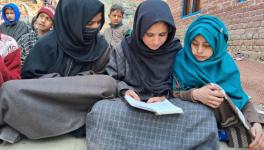Read this Story About Struggles of Kashmiri Stringers
For representational use only.
On 30 October 2018, harvesting season was at its peak in Kashmir. Aijaz Dar, a scribe from the apple-rich Shopian district, around 50 km south of Srinagar, received a WhatsApp message about an attack on security forces in the area. He immediately put his camera in his rucksack and dashed for the trouble spot.
By then, the security forces had ring-fenced the entire area to track down the militants, and a knot of young men was hurling rocks at the security forces to deter the search operation. The forces used tear gas shells and shotgun pellets to scare them away.
Dar was caught in the cross-hairs. He received multiple pellets in his head and was rushed to a hospital.
Soaked in blood and sobbing in excruciating pain, Dar, who then worked as a stringer with a New Delhi-based television channel, ensured the visuals he had captured reached the organisation.
However, five years down the line, Dar recounts how his former employers exploited him.
“The remuneration was chicken feed for the work I did,” says he.
Dar, who majored in history and journalism in college, started working as a stringer in 2008 and covers primarily the troubled southern parts of the Kashmir valley.
The area is the epicentre of what many security analysts call ‘new-age’ militancy, which re-animated after the Hizbul Mujahadeen commander Burhan Wani was shot dead by security forces in 2016.
Firefights between the security forces and militants would occur practically every day in this area in those years. And it spurred almost every New Delhi-based television channel, as well as some digital media platforms, to depute their stringers in the region—and exploit their work.
“Sometimes I would earn [just] between Rs 500 to Rs 1,000 in a month,” says Dar.
After more than a decade in the field, Dar was lucky enough to get a job as a reporter with a national media outlet after he found some kind journalists who did not take advantage of his hard work.
This author interviewed many stringers from different parts of Kashmir for this article and found that, on average, a stringer is paid between Rs 300 to Rs 1,000 for a video story.
In some instances, stringers are paid between Rs 100 to Rs 150 for news feeds or even made to work free.
Other stringers
Qaisar Ahmad Mir, a young stringer from Pulwama, said he earns between Rs 300 to Rs 1,000 a month.
Like Dar, Mir has had several brushes with death while covering gun battles.
On 14 June 2019, Mir was filming one such incident in Braw Bandina, an outlying village in South Kashmir’s Awantipora area, for a New Delhi-based television channel when bullets whizzed over his head.
“For a split second, I thought the bullets grazed my head,” Mir said. He said the stringers put their heads on the line but never get adequately compensated.
Wani Majid, a stringer-turned-businessman, said he called it quits as he could not make ends meet after several years of trying to make it work as a journalist.
“They would release only half the payment I was owed for my work, five or six months delayed. I found myself badly off,” said Majid, who covered central and north Kashmir for many Delhi-based television channels for over seven years.
“Now I have started my business,” he added.
Bureau-Level Exploitation
Stringers are the foot soldiers of any print, television or digital media outlet and often the first responders to events, good or bad. They work in small towns and far-off villages with their ears to the ground. One of their duties is to keep the “bureaus” of media outlets posted about developments. These bureaus and their chiefs usually are in big cities and rely on stringers to inform them about and report on most crucial developments.
However, some bureau chiefs not only broadcast the work of stringers as if it were their own report but are also disinclined to have their payments cleared.
“They don’t give us credit for the video stories we file from the ground,” said a young Kulgam-based stringer, who declined to be identified by name.
He alleged his bureau head ran many of his stories as if he had reported them, erasing the name of the stringer.
He also claimed that some Jammu and Kashmir-based bureau chiefs have little original work to show if they had not taken credit for stories produced by stringers like himself.
“We are not provided with the transport costs even if we are made to travel miles to cover a story,” the young journalist said.
Another journalist from the area said his bureau chief deliberately withheld his payment.
“They want a cut from our payment, too,” he alleged.
Blackmailing stringers
Some senior journalists and representatives of press bodies believe that the exploitation of stringers by their organisations has spurred many stringers to either charge local administration for running the stories or resort to blackmail.
“Making them work on low or no payment at all is one of the core reasons they blackmail officials,” said Fayaz Wani, a senior journalist and spokesperson Jammu and Kashmir Press Association.
Another Kashmir-based senior journalist, who did not wish to be named either, said that even qualified stringers are forced to work even without payments because of the lack of opportunities.
“They just want [need] to remain in circulation,” he said.
He, however, said that at some later stage, when “they have to shoulder the responsibility of their families, they resort to unfair means”.
This journalist added that the issue would not be resolved unless the stringers raised their voice against their exploration and demanded the implementation of labour laws in letter and spirit.
No data
The Valley abounds with stringers. However, no data is available from the Department of Information about the number of stringers working in Kashmir for outstation television channels and digital platforms.
An official said they only had data on accredited journalists working in the region. According to the official, there are 171 accredited journalists working in Kashmir and 151 from Jammu.
The author is an independent journalist. The views are personal.
Get the latest reports & analysis with people's perspective on Protests, movements & deep analytical videos, discussions of the current affairs in your Telegram app. Subscribe to NewsClick's Telegram channel & get Real-Time updates on stories, as they get published on our website.
























